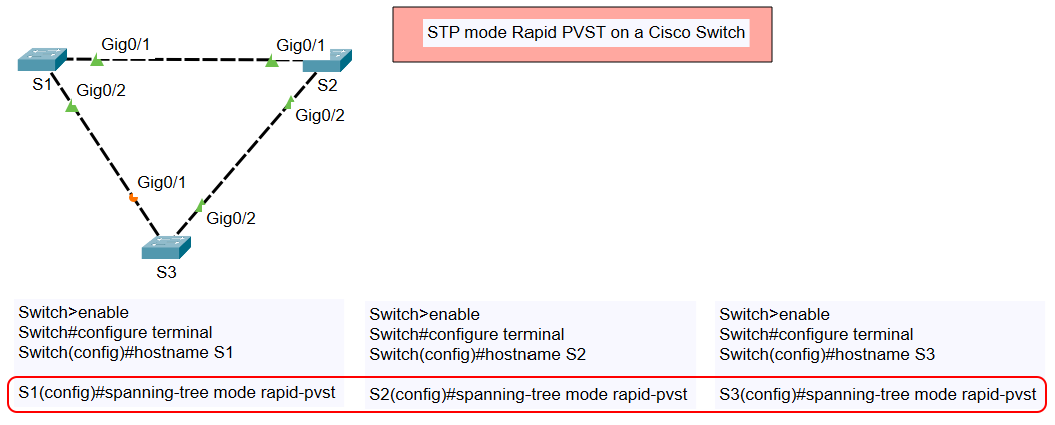Configure STP Mode Rapid PVST on a Cisco Switch
Rapid Per VLAN Spanning Tree Protocol (Rapid PVST) is an enhanced version of the Spanning Tree Protocol (STP) that allows for faster convergence in a network topology. This guide will demonstrate how to configure the Rapid PVST mode on Cisco switches using the provided topology.
STP
- Configure STP mode PVST on a Cisco Switch
- Configure STP mode Rapid PVST on a Cisco Switch
- Configure STP mode Rapid PVST with PortFast on a Cisco Switch
Network Topology Overview

The topology consists of three interconnected switches:
- Switch S1: Interfaces Gig0/1 and Gig0/2
- Switch S2: Interfaces Gig0/1 and Gig0/2
- Switch S3: Interfaces Gig0/1 and Gig0/2
The objective is to enable Rapid PVST on all three switches to ensure efficient network convergence and loop prevention.
Steps to Configure Rapid PVST on Cisco Switches
Step 1: Access the Switch CLI
Connect to each switch using a console cable or SSH session.
Step 2: Enter Global Configuration Mode
To configure Rapid PVST, follow these steps on each switch:
- Access privileged EXEC mode:
Switch> enable - Enter global configuration mode:
Switch# configure terminal - Assign a hostname to the switch (optional but recommended):
- For Switch S1:
Switch(config)# hostname S1 - For Switch S2:
Switch(config)# hostname S2 - For Switch S3:
Switch(config)# hostname S3
- For Switch S1:
Step 3: Configure Rapid PVST Mode
To enable Rapid PVST on each switch, execute the following commands:
- On Switch S1:
S1(config)# spanning-tree mode rapid-pvst - On Switch S2:
S2(config)# spanning-tree mode rapid-pvst - On Switch S3:
S3(config)# spanning-tree mode rapid-pvst
Step 4: Save the Configuration
After configuring Rapid PVST, save the configuration to ensure it persists after a reboot:
- On each switch:
S1# write memory S2# write memory S3# write memory
Step 5: Verify the Configuration
Use the following commands to verify that Rapid PVST is enabled:
- Check the spanning-tree mode:
S1# show spanning-tree summaryThis should indicate that the spanning-tree mode is set to Rapid PVST.
- Display spanning-tree details:
S1# show spanning-treeThis will provide information about the spanning-tree status for each VLAN.
Benefits of Rapid PVST
- Faster Convergence: Rapid PVST allows for rapid re-convergence of the spanning tree when topology changes occur.
- Per-VLAN Instances: Each VLAN can have its spanning-tree instance, offering granular control and optimization.
- Loop Prevention: Ensures a loop-free topology in a redundant network setup.
Conclusion
By enabling Rapid PVST mode on Cisco switches, you can achieve faster convergence and improved network efficiency. Ensure that all switches in the topology are configured consistently to maintain seamless connectivity. Refer to the topology diagram to validate the interconnections and configuration.
For further assistance or more in-depth tutorials on Cisco networking, stay tuned to our blog!